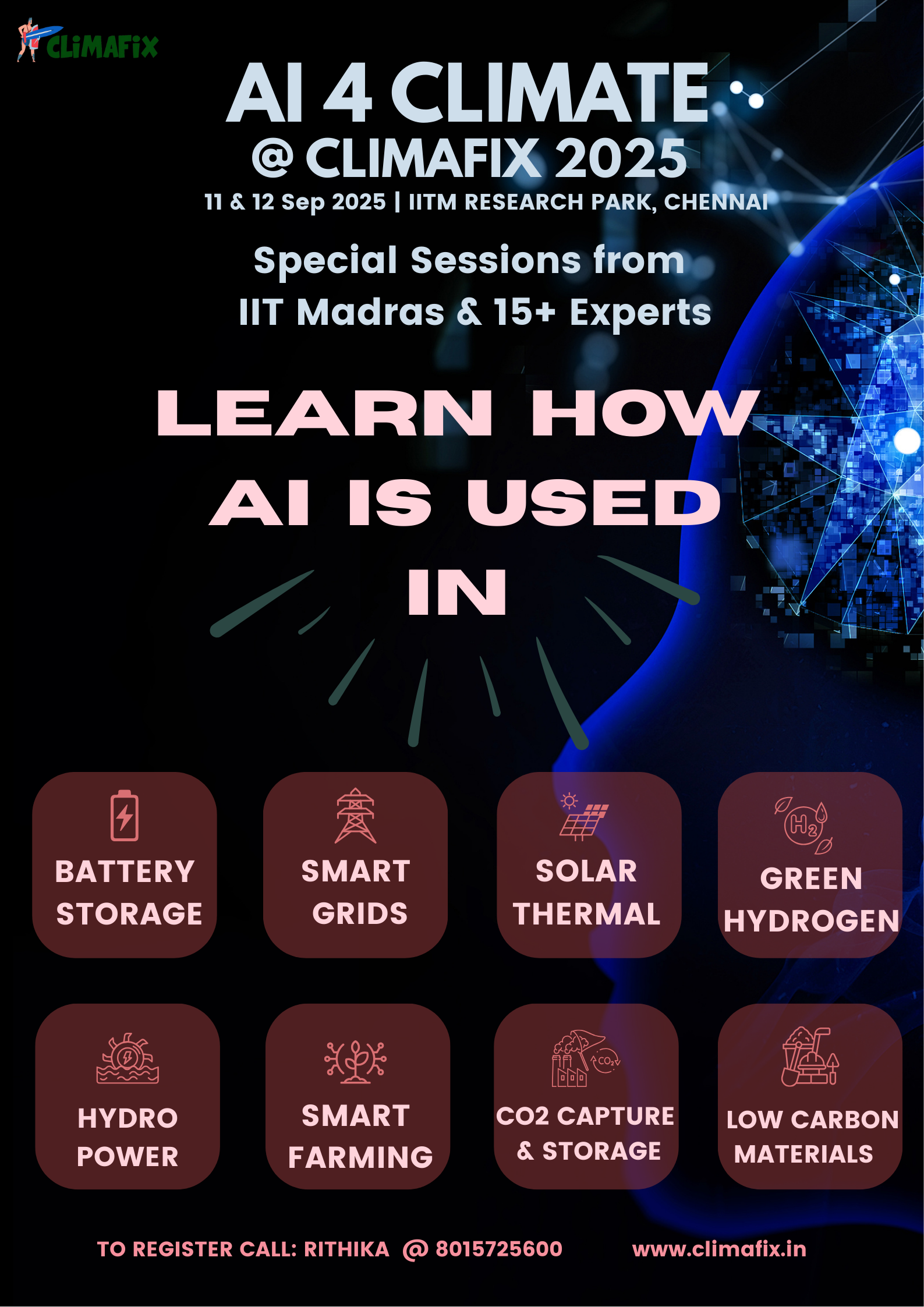Multiple Sessions at CLIMAFIX Summit 2025

Join us at IIT Madras Research Park, Chennai
September 11–12, 2025
Call Rithika For More Details | 80157 25600
AI Applications in Climate Action
Clean Energy
AI is revolutionizing clean energy by improving efficiency, reliability, and sustainability by optimizing generation, managing smart grids, predicting maintenance, and enabling better energy use across systems.
Key Applications:
- Renewable Energy Forecasting
- Smart Grid Management & Demand Response
- Predictive Maintenance
- Precipitation pattern forecasting
Energy Efficiency
In energy efficiency, AI analyzes usage patterns, detects inefficiencies, and automates optimization by reducing waste and cutting costs in buildings, industry, and infrastructure.
Key Applications:
- Smart Energy Management Systems
- Predictive HVAC Control
- Industrial Process Optimization
- Real-Time Energy Monitoring & Analytics
Energy Storage and Grid
In energy storage and grid management, AI enhances reliability by predicting demand, optimizing battery usage, and balancing renewable supply with consumption by supporting a more resilient, flexible energy system.
Key Applications:
- Battery Performance Optimization
- Energy Demand Forecasting
- Smart Grid Load Balancing
- Soil quality analysis
Industrial Decarbonization
AI reduces industrial emissions by using real-time data analytics and predictive modeling to optimize processes. It applies machine learning for carbon tracking, equipment efficiency, and energy use reduction.
Key Applications:
- Supply Chain Optimization
- Process optimization
- Emissions Monitoring
- Predictive Maintenance
Waste Management
AI improves waste management by using computer vision and robotics for automated sorting. It applies predictive analytics to optimize collection routes and enhance recycling efficiency.
Key Applications:
- Automated Waste Sorting
- Collection Route Optimization
- Waste Generation Forecasting
- Recycling Process Optimization
Materials
AI advances materials recycling, such as biomaterials and industrial resources by using machine learning to identify, separate, and process materials efficiently. It optimizes recovery methods, predicts resource demand, and reduces production waste.
Key Applications:
- Intelligent Material Identification & Sorting
- Process Optimization for High-Value Recovery
- Resource Demand & Supply Forecasting
- Waste-to-Resource Conversion Modeling
AI Climate Impact by Numbers
Why Learn AI for Climate?
Career Opportunities
The intersection of AI and climate creates high-demand career paths in sustainability consulting, green tech startups, and environmental research organizations.
Global Impact
Contribute to solving the world's most pressing environmental challenges while developing cutting-edge technical skills that make a real difference.
Innovation Leadership
Be at the forefront of technological innovation, creating solutions that combine artificial intelligence with environmental science for sustainable development.
Collaborative Network
Join a global community of researchers, entrepreneurs, and activists working together to address climate change through technology and innovation.
Measurable Results
Work on projects with quantifiable environmental impact, from reducing carbon emissions to improving energy efficiency and conservation efforts.
Research Excellence
Access to cutting-edge research, datasets, and tools that advance both AI capabilities and climate science understanding.
Event Agenda
Discover the full agenda for ClimaFix 2025! Engage with inspiring keynotes, hands-on workshops, and interactive networking sessions—designed to drive innovation and impactful climate solutions.
AI 4 Climate at the CLIMAFIX Summit 2025
India's Largest Climate Startup Summit
September 11–12, 2025
